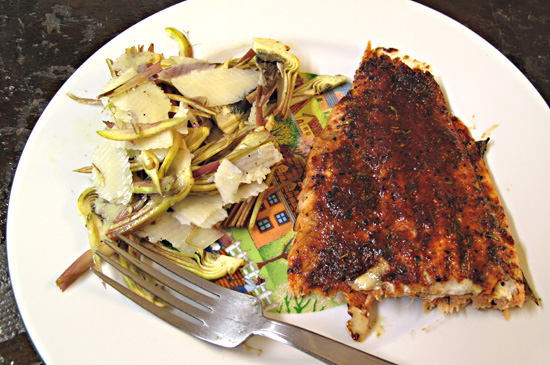by Maureen | Mar 5, 2010 | Food!, Introspection, Journal, Meals
I harkened back to my German roots today and cooked sausage in a kraut of red cabbage, beets and onions. I could post a photo, but it really is just a mass of purple-brown and doesn’t look like much. But it tasted good. It shouldn’t seem odd for me to cook such a thing. Half of me is German, and Germany is just up and over the hill. And I always cook a wild-and-crazy blend of who-knows-what kind of food origin. Just because I’m in Italy, you think I’m going to cook “Italian” all the time? (What is that, anyway?)
I have enough leftovers for two more meals, sigh. Need to have my appreciative brother close by to eat what I make.
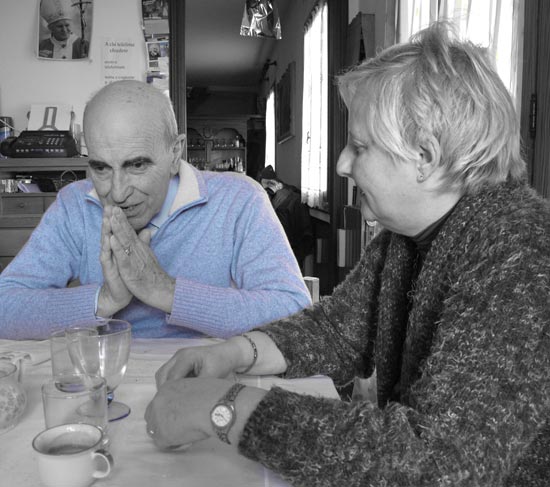
by Maureen | Mar 1, 2010 | Cheese, Featured Articles, Food!, Incredible Locations, Journal, Meals, People, Photos, Sanremo
Dinner the night before was followed by a long lunch the next day. Renata and Angelo, who live in a town within walking distance from Sanremo, were having some friends over on Sunday and I was invited to come along. So gracious! It’s a real treasure to have people open their doors and ask me to join them in their homes.
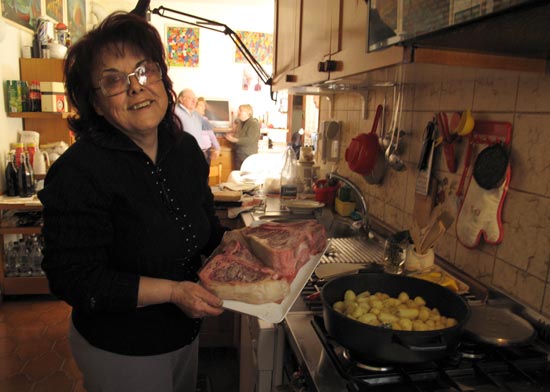
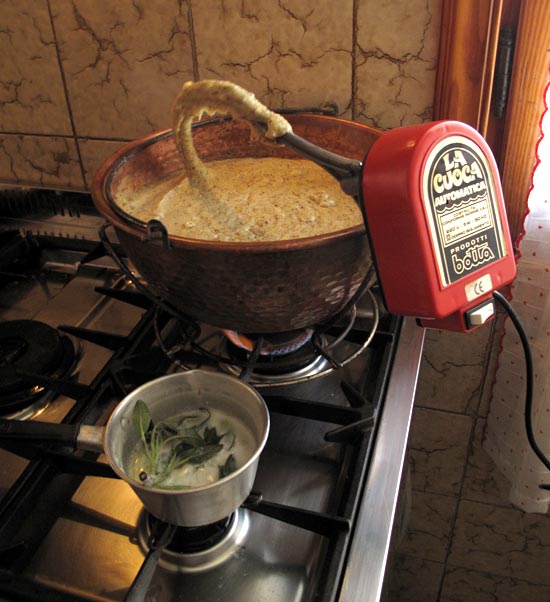
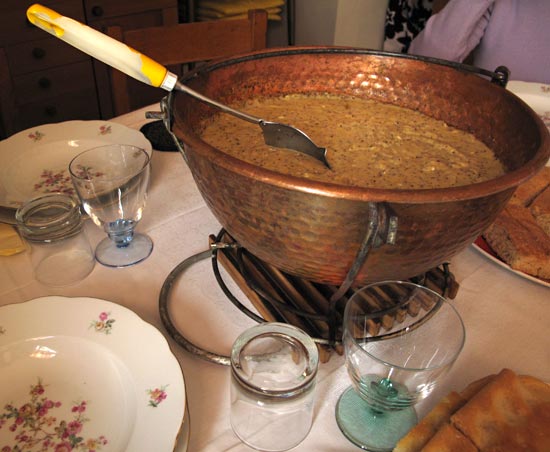
By a little before one o’clock, 8 people had clustered in the kitchen and around the dining table. Renata and Angelo had been cooking all day for us and piled the table high:
- Genovese focaccia – plain, with oil.
- Sardenara – Ligurian specialty focaccia with tomato sauce,
anchovies, olives, oregano and garlic.
- Carciofi Impanati Friti – breaded, deep-fried, small young artichokes.
- Maiale Cicioli – breaded, deep-fried pieces of pig fat.
- Patate – little baby potatoes, roasted with olive oil.
- Polenta Taragna Concia – a regional style of polenta with ground buckwheat and 1 kilo of cheese. It cooked over the stove in a copper kettle for more than an hour, with a motorized stirring paddle to mix it and keep it from sticking.
- T-Bone Steaks – the thickest t-bones I’ve ever seen were grilled outside ’til rare. The meat was cut away from the bone, then sliced and served.
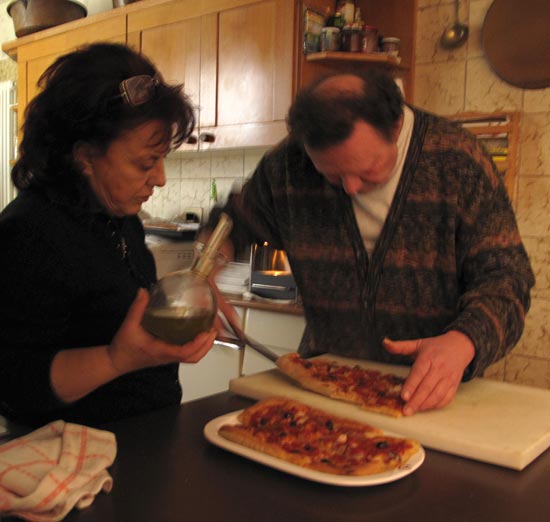
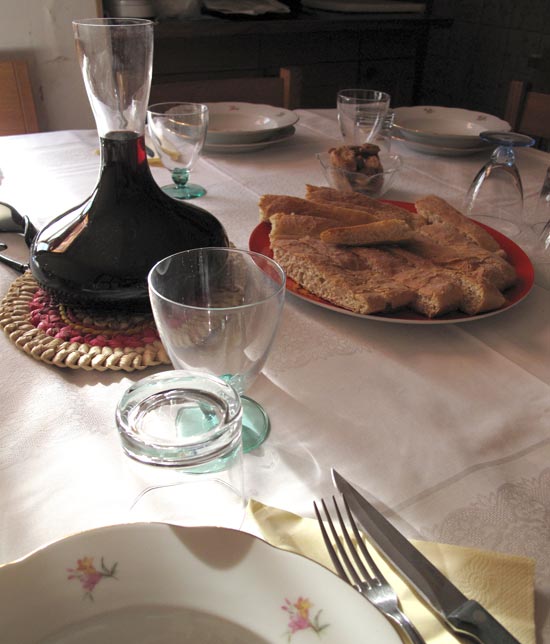
The sweets at the end of the meal included:
- Bugie – (which means “lies”) crispy, fried, sugar-dusted twists of dough.
- Nutella-topped sweet buns
- Baked Pears – Angelo got up from the table several hours into the afternoon and prepared baked pears by crushing amaretto cookies, mixing them with chocolate and liqueur, and pouring this blend onto the pears before quick baking.
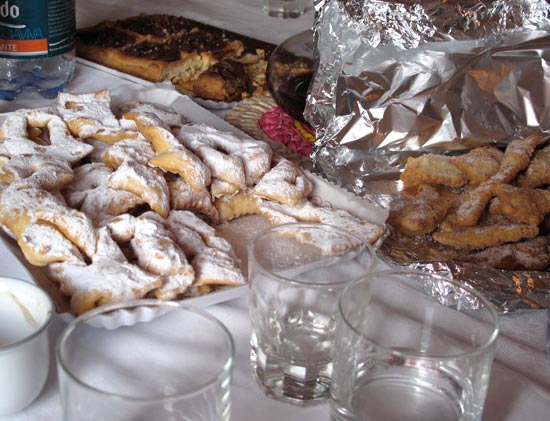
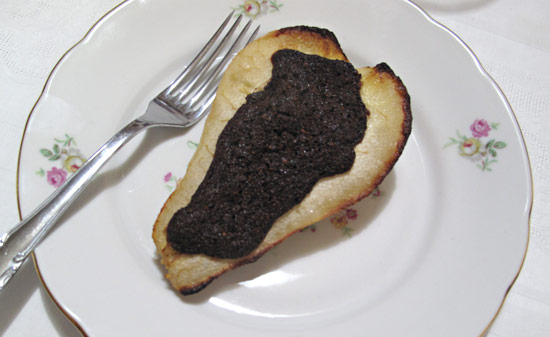
The food went around. The home-bottled chianti, extra-proof, flowed, as did the conversation. I understood most of it and jumped in when I had something to add. Though I had shot photos of Renata in the kitchen when I first arrived (feeling comfortable since we’d had dinner together the night before), I kept my camera tucked away for the first couple hours of the meal. These people didn’t know me and I didn’t want to be rude.
To lubricate the conversation, we had begun with the chianti, then moved on to champagne, grappa, rum and caffé. Time was passing and everyone was loosening up. I was treated to a display of classic Italian hand gestures, mannerisms and animated speech. So theatrical, you would have thought it had been scripted. Eventually, my camera came back out and I had fun snagging images as the hours ticked by.
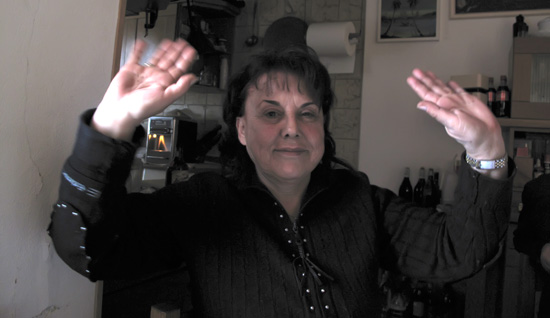
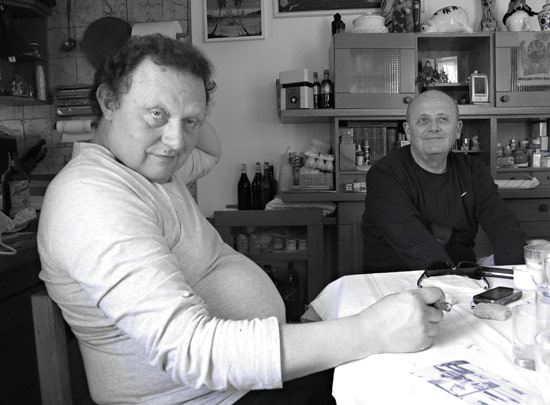
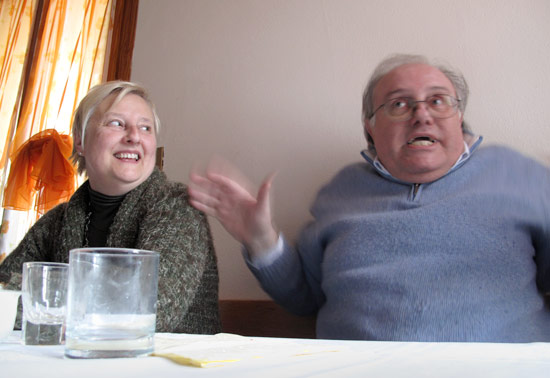

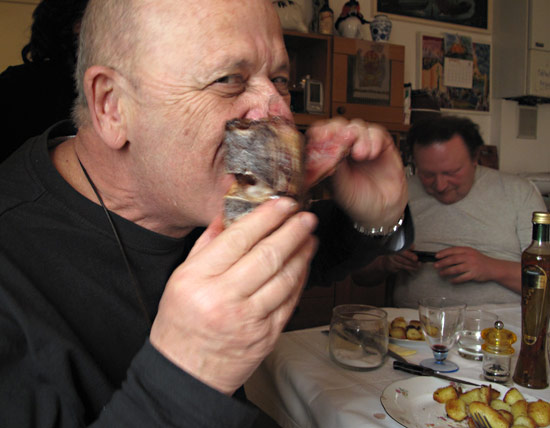
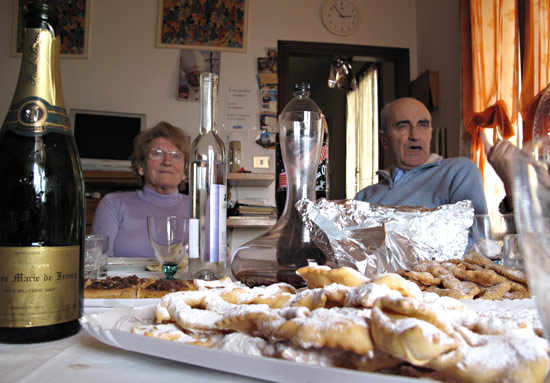
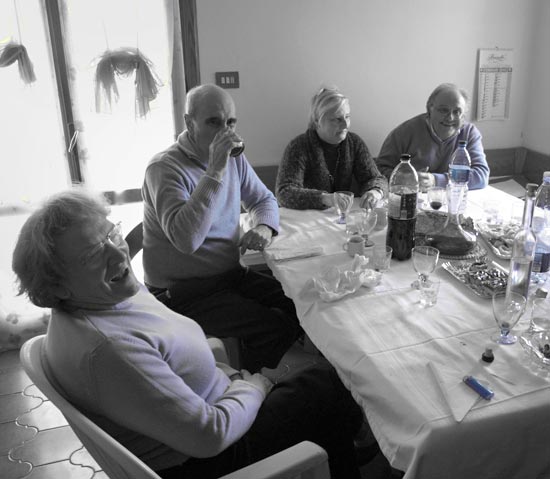
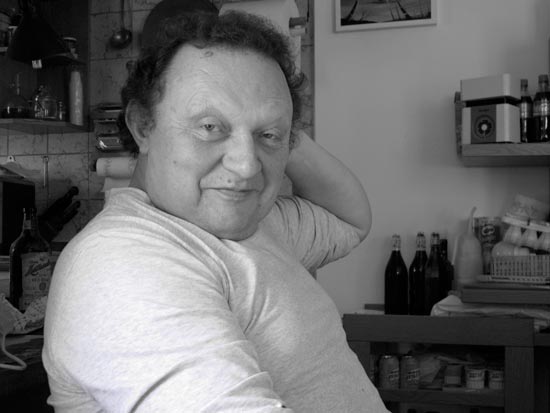
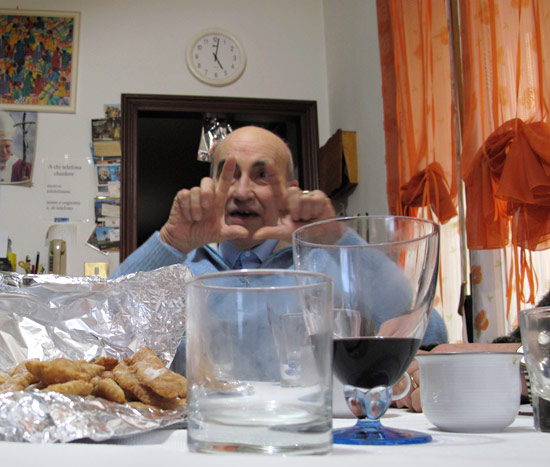
The first part of the day had been blue-sky serene, the kind of day that brings the crowds to the Ligurian* seaside. As we passed the afternoon in lively discussion at the table, the sky had darkened, a wind picked up and waves were crashing at Renata and Angelo’s bulkhead. It was time to go home at close to 7:00.
*Liguria is the “Italian Riviera”, that northern region of Italy that includes Cinque Terre at its southeastern end and arcs from there northwesterly to France.
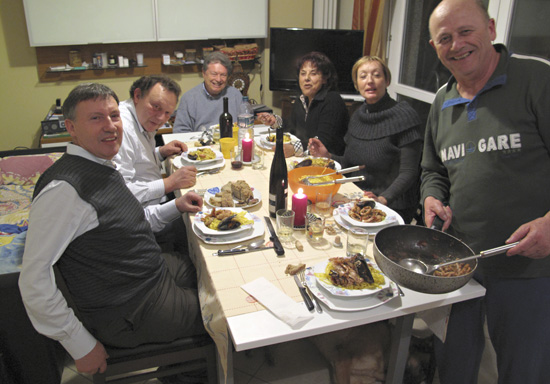
by Maureen | Feb 28, 2010 | Food!, Incredible Locations, Journal, Meals, People, Photos, Sanremo
It’s a natural for friends to gather for food and conversation. This is worldwide, but I find that the Italians do it well and do it often.
Last weekend, in Sanremo, seven of us got together for dinner around the table: my landlady, Sandra, and her husband, Mauro, and their friend, Sandro (all of whom I had spent the weekend with two weeks earlier), plus two friends of theirs, Renata and Angelo, and another friend of Sandro’s, Livio. Everyone came with food in hand, and we had a lively time.
Below, left to right: Livio, Angelo, Mauro, Renata, Sandra, Sandro.

We started with some salame that Livio had made. (Yes. Those are chunks of fat.) I had made a loaf of mixed-grain Irish Soda Bread that we ate with it.
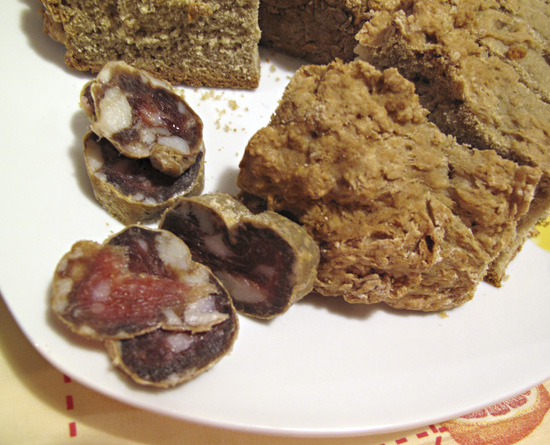
Sandro had cooked a fabulous mix of seafood, including mussels, shrimp, squid, pescatrice (that funny, deep-water fish with the “lure” hanging off the front of its head), and tiny 3 inch fillets of a local, sand-versus-mud fish. There was just a tad of hot pepper oil in this dish which added a touch of zing.
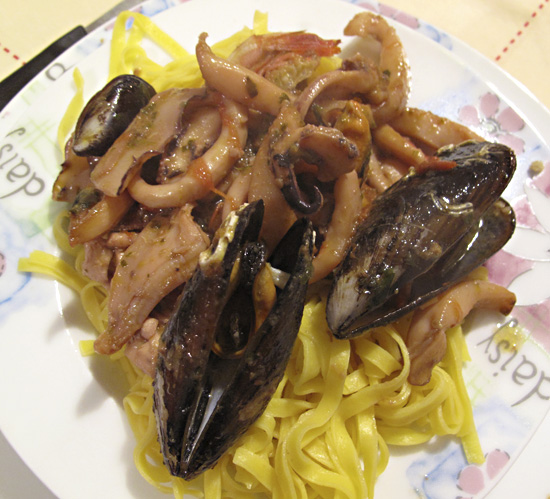
Renata had baked a fresh tart, beautiful with apple wedges emerging from the deep gold, dense, pound cake. This was pretty darned good with some of the array of gelato that Sandra and Mauro had picked up at the town’s best Gelateria. We ate and talked for close to three hours. (Yes. All in Italian.)
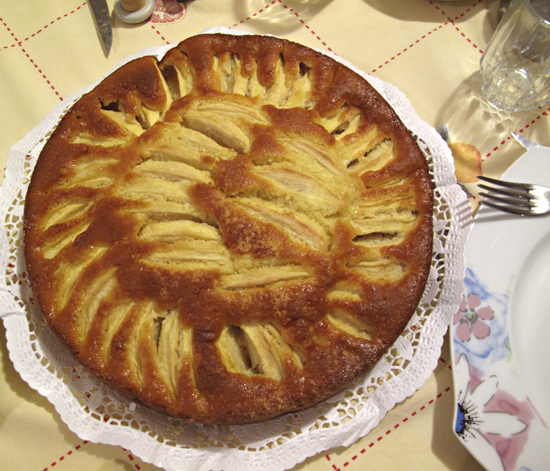
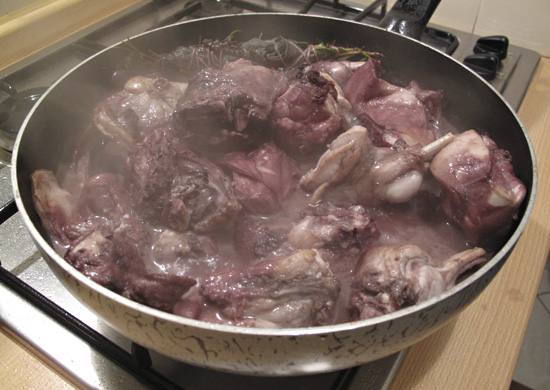
by Maureen | Feb 28, 2010 | Featured Articles, Food!, Incredible Locations, Journal, Meals, Sanremo
It’s an old time, secret family recipe and I took an oath not to reveal the ingredients, but I can show a couple of photos and give just a sketchy description.

Essentially, you cut up a rabbit, brown the chunks, simmer them in all the right liquids* with all the right seasonings* ’til the meat is tender*.
In the meantime, you take a big fistful of raw rabbit livers and pureé them with all the appropriate Italian ingredients* until you’ve got a smooth, pink slurry.
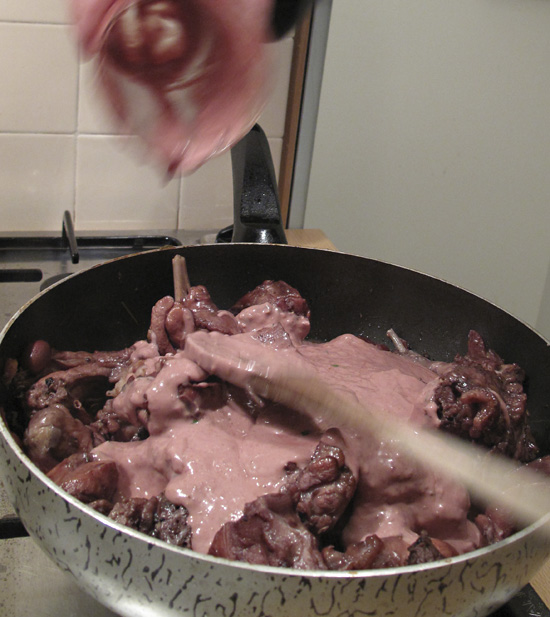
When the meat chunks are done just right*, and with the heat OFF, pour the rabbit liver slurry into the pan with the meat and stir it all around. The remaining heat in the pan and in the meat will “cook” the liver “enough”. The liver will actually coagulate rather than remain saucy.
Scoop up some of the thickened “sauce” and serve it over fresh tagliatelle pasta. It’s appropriate to eat the chunks of rabbit with your hands.
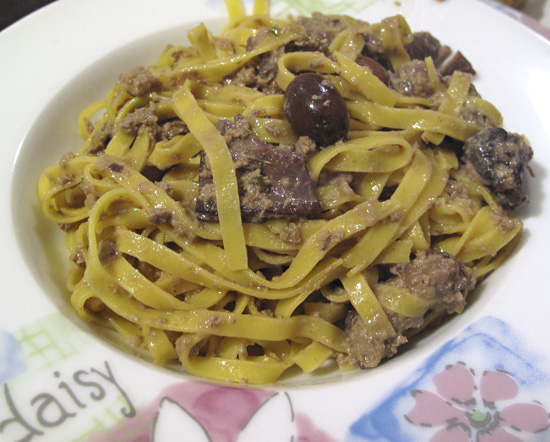
If you’re a fan of liver, this is fabulous! If not, well…
I’m grateful to chef Sandro, in Sanremo, for preparing this for me and letting me watch and take notes!
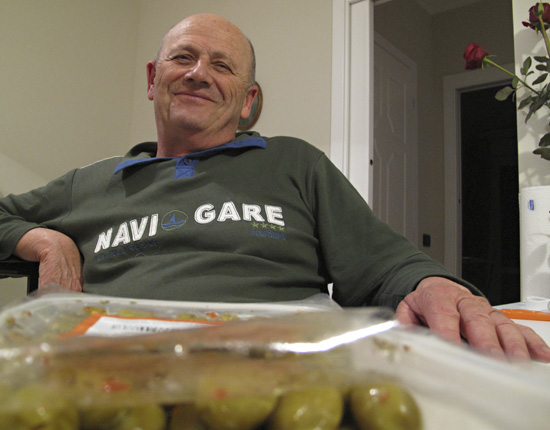
*If you’ve had enough experience in the kitchen, you can use your imagination to figure out what these things MIGHT be.
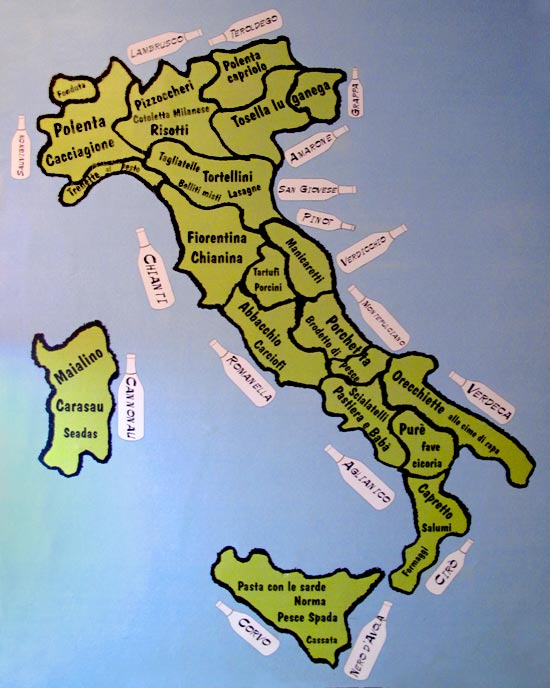
by Maureen | Feb 28, 2010 | Cheese, Food!, Introspection, Journal
In reading my blog posts about what I’m eating here, I hope that you’ll realize how much broader the Italian culinary range is than the stereotypical American concept of “Italian Food”. There is SO much more than pizza, spaghetti, lasagna and ravioli. “Fettucine Alfredo” is a figment of the American imagination, and I’ve been told emphatically, “NEVER serve tomato sauce on spaghetti!” Italians have laughed at that idea.
You can travel a mere 100 kilometers and encounter regional, traditional foods you couldn’t have found at your last stop. There are foods unique to specific communities!
As an example, depending on the region, the starch base will be different. You may encounter polenta, pasta (of a shape specific to that region), rice (risotto), focaccia or other bread. Wines, meats, cheeses and seasonings all vary by region.
For instance, in my last visits to Sanremo, I was treated to:
- Sardenara – a focaccia bread with tomato sauce, anchovies, garlic and olives (no cheese), specific to Liguria.
- “Branda Cugnon” – A delicious mash of salted, dried white fish (cod?), potato, parsley, olive oil and garlic. (Don’t ask about the bawdy origin of the name.)
- Rabbit with Sauce of Pureéd Rabbit Livers – A secret, family recipe in which the rabbit livers are pureéd with other ingredients (I’m not supposed to tell) until they become a thick, pink slurry. The sauce is then stirred onto the hot, stewed rabbit parts, and is “cooked” only from the residual heat.
- Polenta Taragna Concia – Yellow, coarse polenta (cornmeal) with ground buckwheat and a kilo of cheese stirred and cooked into it over the stove for an hour.
The next time you want to go out for “Italian Food”, stretch beyond what you’re familiar with and either go to a restaurant that offers more authentically prepared foods, or pick something off the menu other than your tried-and-true favorite. Order something you can’t identify. I do it all the time!
Below is a map that I saw on the wall at Ristorante Re Enzo in Bologna. It mentions just a few of the noted food and wine specialties for each region.

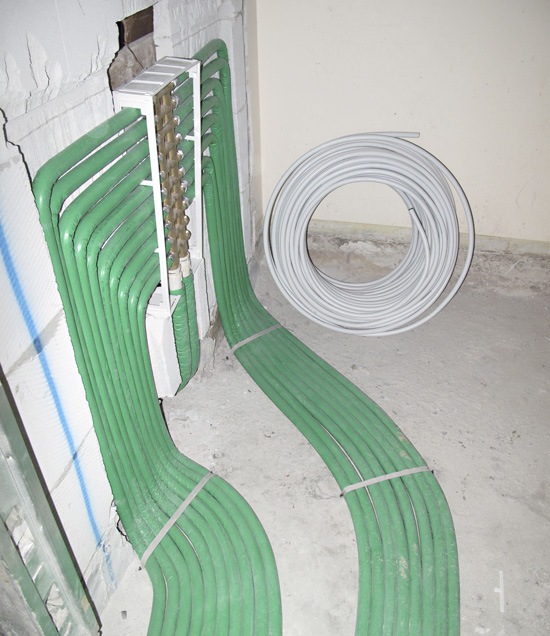
by Maureen | Feb 26, 2010 | Discoveries, Featured Articles, Incredible Locations, Journal, Photos, Sanremo
How many people travel to Italy and include construction shots in their set of “vacation photos”? When I went to see an apartment being remodeled I didn’t realize how fascinating it would be. (Then I thought of my family members and friends that would also be interested and I started shooting photos.)
This apartment, or condo, in a 50-year-old, 6-story building in Sanremo has been completely gutted, peeled of it’s stucco and old-time, old-lady wallpaper. I was struck by how DIFFERENT this construction is than our 2x4s on 16″ centers, skinned with sheetrock. Notice that everything is stone-based, (as are all structures here, except for high-rises). Even the interior walls are some sort of white plaster/concrete block. The old floor has been excavated to about 6-8 inches below final grade so they can lay down the new water and heating system.
In this photo we’re looking into the entry foyer with the front door inside and to the left.
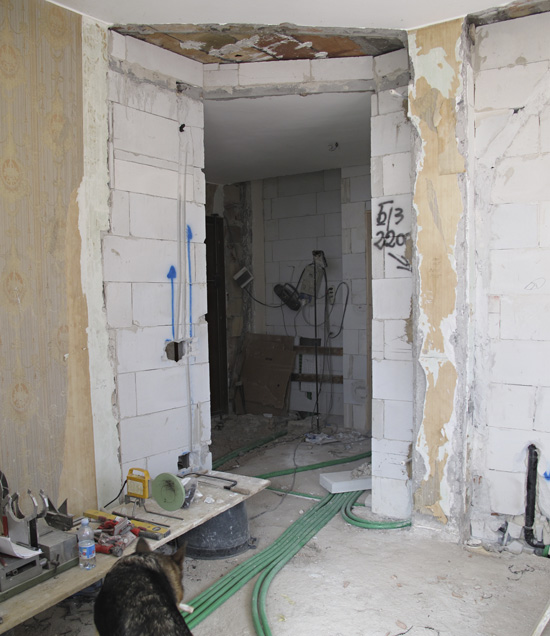
The hot water tubing is green, flexible and multi-layered. The cold water runs through the narrower, white tubing. Both have an interior plastic layer, surrounded by metal, surrounded by plastic. The hot water tubing is encased in fairly soft, green foam insulation. Each route is one continuous run of tubing, except for occasional t-joints. And, yes, you can walk on the tubing after it’s been set out and it won’t crush under normal foot traffic.
Why is there so much green tubing running through this two-bedroom apartment? All the homes here have wall-mounted radiator heaters. No forced-air heat. No baseboard, electric heaters that are typical in much of the U.S.
Note how the floor has been carved out to accommodate several layers of overlapping tubing. In the end, a thick layer of concrete will be floated over the whole floor, encasing all of the tubing and its structure. Ceramic floor tiles will be the finishing surface.
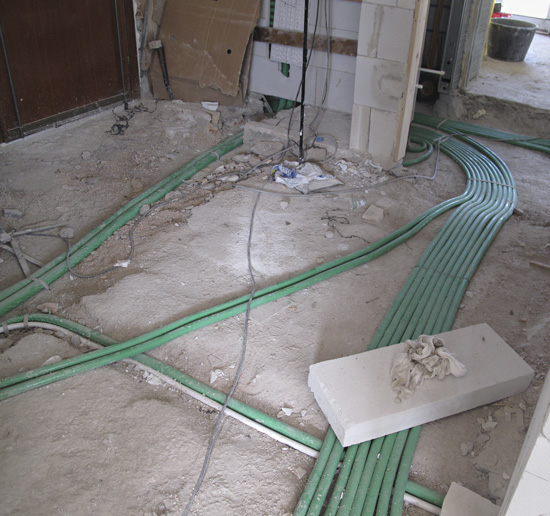
This is the main junction box where all tubing joins. Very neatly done! And notice how the snakes of tubing are anchored with woven strapping to the raw floor.

Here’s the tubing laid out for one of the two bathrooms. The black pipe is the wastewater route. Notice how they’ve simply gouged a groove into the cement block wall to position the tubing that runs upward for the shower.
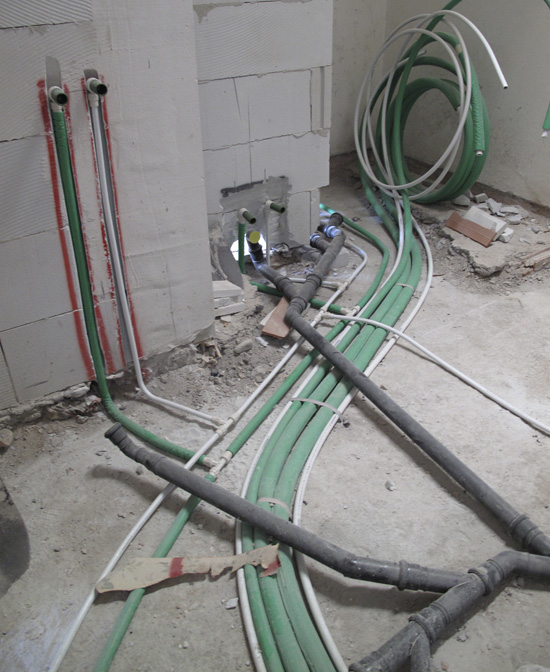
T-Joints and anchors. And I love that little diamond-shaped rough chunk of cement block spacing the white and green tubes.
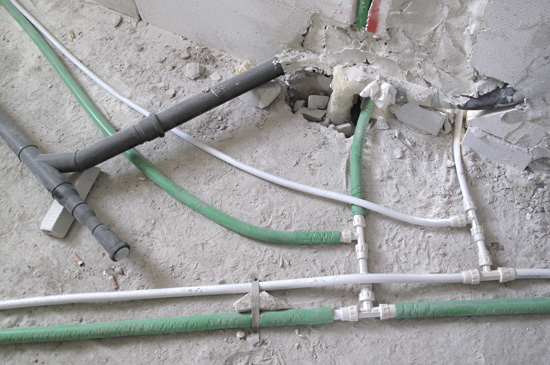
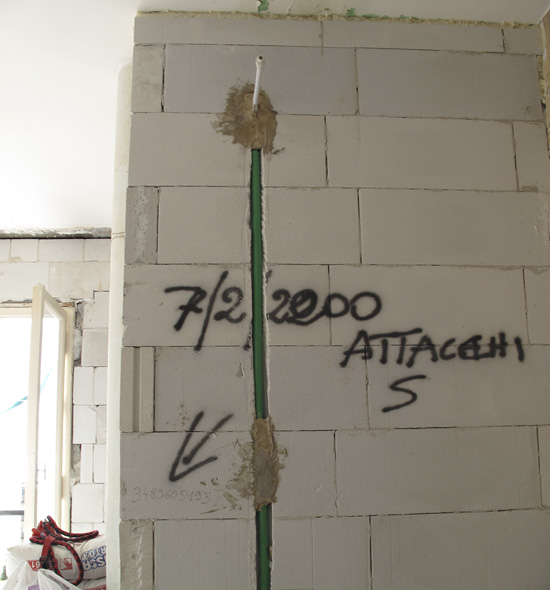
Do you know what this is (below)? This is the water supply for the flushing mechanism of the toilet and it, too, will be encased in the wall! My mind imagines potential problems down the road with the system and having to rip apart the floor and wall for repair. Ugh.
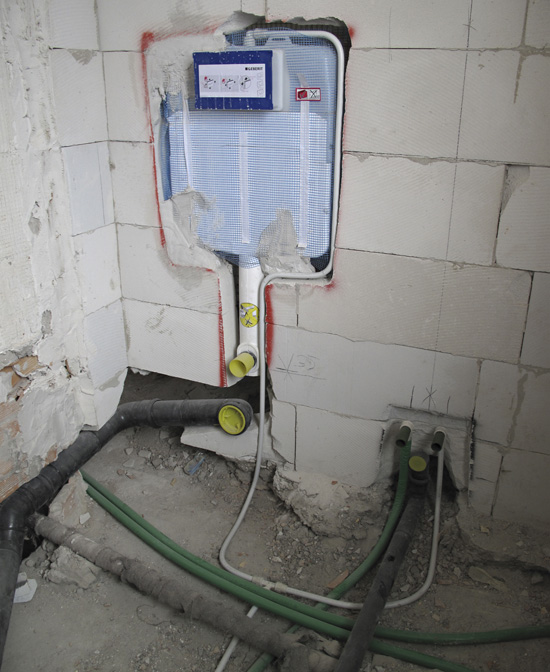
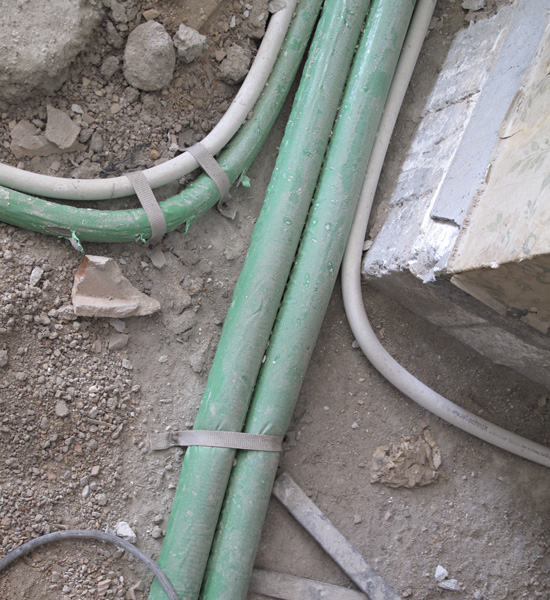

by Maureen | Feb 1, 2010 | Bologna, Discoveries, Featured Articles, Food!, Incredible Locations, Journal, People, Photos, Shopping & Markets
Years ago, a girlfriend of mine from Seattle traveled and stayed with Marcello and Raffaella Tori of BluOne Cooking Tours in Bologna. When my girlfriend, Carri, returned home to Seattle, she kept talking with great fondness about the couple, their big hearts, and the wonderful time spent with them.

For 15 years, Marcello and Raffaella have been offering small, guided culinary tours customized for food lovers, home cooks and pro chefs. Talk about a foodie’s delight! They are based in Bologna, but also lead their cooking adventures in Emilia Romagna, Umbria, Le Marche, Piemonte and other regions of Italy.
The other day when I decided to go to Bologna for the weekend, I got in touch with Marcello and Raffaella and asked if we could meet for even a few minutes. I didn’t want to disturb their weekend plans, but wanted to at least get a photo of them to send to Carri. We e-mailed back and forth a few times and chatted by phone to make arrangements.
I showed up at their home yesterday at 5:00, (a half hour later than we had planned). They opened their door, greeted me with big hellos and sat me down at their kitchen table for tea and freshly baked apple tart (which perfumed the house). We talked for a couple of hours, and laughed and shared ideas about a hundred different things. When it was time for me to dash back into town to catch my train home, we exchanged hugs, kisses and vows to share a long, delicious dinner next time.
I walked away with new friends in my life.
If you’re looking for a more interesting vacation in Italy, something memorable that takes you into the homes and hearts of people, I can’t think of a dearer couple to lead your way. Through food and fun, Marcello and Raffaella will create a never-to-be-forgotten time in your life.
Marcello & Raffaella Tori
Bluone – Cooking Tours in Italy
Via Parigi, 11 40121 Bologna – Italy
Phone +39 051 263546
Fax +39 051 267774
Web: www.bluone.com
E-Mail: info@bluone.com
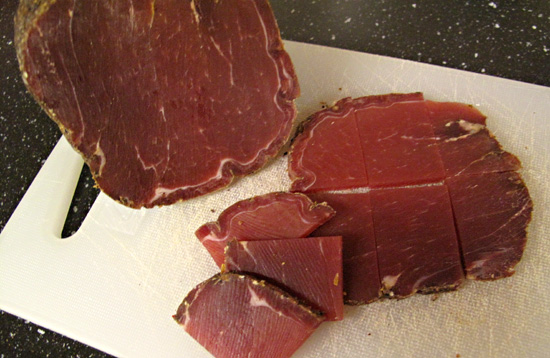
by Maureen | Jan 20, 2010 | Discoveries, Food!, Journal, Shopping & Markets
Mmm. It’s 10:00 p.m. and I just cut into a big chunk of Cinghiale Bresaola – uncooked, aged, wild boar meat. (Cinghiale: ching-GHYA-lay) Yum. So good. Peppered on the outside. Dense/firm. Deep red.

I bought it at the artisanal fair the beginning of last December when I sampled foods from every region in Italy. It’s been waiting for the right moment since then. The woman at the booth gave me samples of bresaola, lardo, prosciutto, salami… I didn’t need dinner that night!
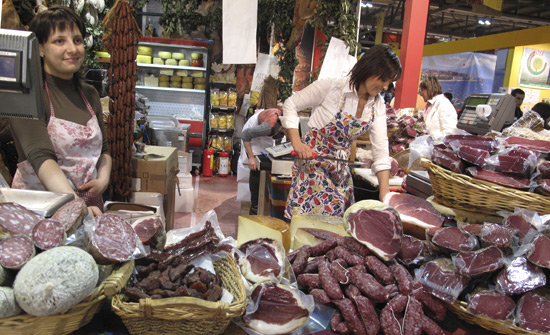
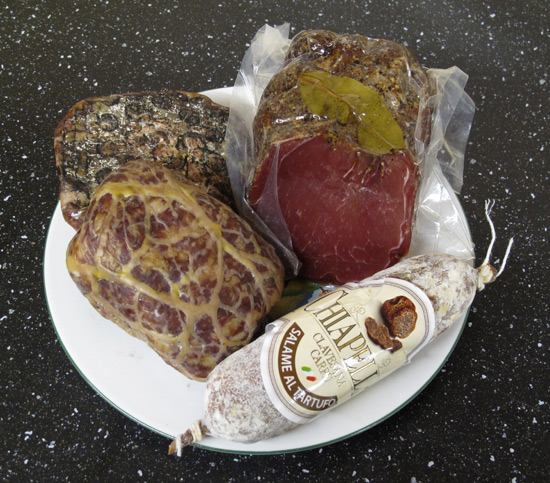
Here’s some further reading about cinghiale.
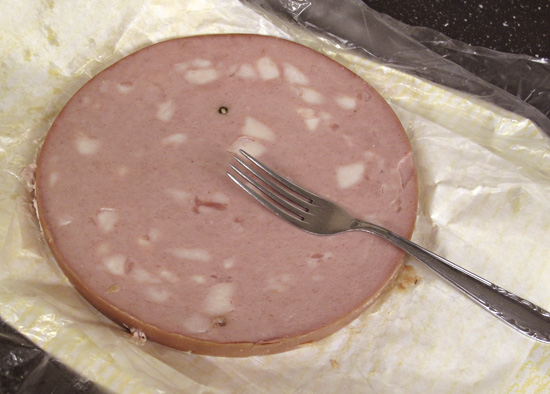
by Maureen | Jan 17, 2010 | Cheese, Discoveries, Featured Articles, Food!, Journal, Meals, Quips
This could easily be the next big thing. The new, chic food. All it would take is some hip New York restaurant to put it on the menu and spread the word. Or a Guru T.V. Show Chef to rave about it: The All-American Grilled Mortadella Burger.

You could cut a half inch thick slab of Mortadella into burger sized rounds, put those pieces on the grill with some wood chips for a little smokiness, then cook ’em hot ’til those little cubes of fat are translucent and dripping onto the coals. Flip those slabs and cook ’em some more.
You could go “classic” burger, with a white bun, cheddar cheese, tomato, lettuce, ketchup and yellow mustard. Or elevate the burger to gourmet on an artisan bun with some perfect Italian cheese, spicy/sweet mustard from the Trentino-Alto Adige region and a slice of tomato. Arugula instead of lettuce?
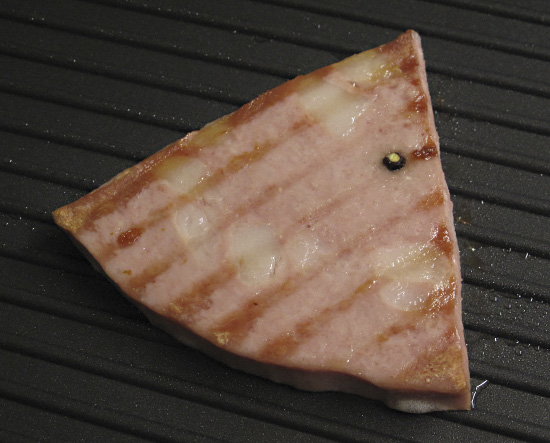
I usually see Mortadella as a sausage over 8 inches wide, scattered with lovely little cubes of fat throughout the ground “meat”. Peppercorns and pistachios are here and there throughout. Don’t call it “baloney”, although that’s the closest equivalent in the U.S.
Mortadella has origins in the town of Bologna and has been made for hundreds of years by very resourceful pig farmers unwilling to waste any part of the animal. Hmm. What does that say about what ends up inside the sausage casing? Do we want to know? Salt, peppercorns, seasonings, wine and pistachios are added to the 7:3 ratio of pork to fat. The Mortadella is cooked, then cooled.
For further information, check out this site: lifeinitaly.com
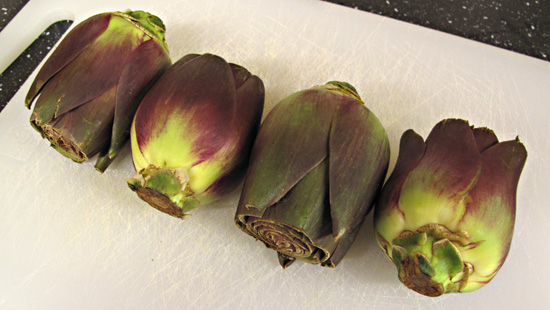
by Maureen | Jan 9, 2010 | Cheese, Christmas & New Year's Eve, Discoveries, Featured Articles, Food!, Journal, Meals, Photos, Shopping & Markets
Have you ever wondered about the first ones to eat something new that they hadn’t encountered before? IS it edible? What PART is edible? Should it be eaten RAW or COOKED? What part do you DISCARD? What part is most DELICIOUS? How is it best PREPARED? What should it be eaten WITH?
Traveling to and cooking in a foreign country is much like being a “primitive man” asking all those questions about newly encountered food items. But at least when you walk into a grocery store or step up to a market stall, someone has done the preselection for you and you’re not out in the woods trying to discern edibility. If it’s in the store, SOME part of it must be edible.
For the last couple of months I’ve been seeing these very small, young, almost-flower-like artichoke heads in the street markets and grocery stores. Very beautiful, but what do they DO with them?! I had no idea, and passed them up, regretfully. I had eaten marinated artichokes scooped out of little jars. Had steamed softball-sized heads and eaten them, leaf-by-leaf dipping the ends in butter. And I’ve eaten that sinfully fat-laden, hot dip with artichoke hearts, cheese, mayo and who knows what else. But I’d never done much else with them or seen them offered other ways. Yes, I’m sure the recipes and methods are out there, but the ones I just mentioned seem to be the across-the-board standards for eating artichokes.
On the evening of New Year’s Day, I was out walking around the Duomo and decided to have dinner out. I picked one of the few restaurants that were open, perused the menu and decided I HAD to have “Insalata di Carciofi Crudi” – Salad of Raw Artichokes! I ordered a “Pizza di Quatro Formaggi” – a four cheese pizza – to go with the salad, but that was secondary in my mind.
What arrived at my table was a bowl with paper thin shavings of very young, tender artichokes, including about an inch of the stem. They had been drizzled with a “fruttato” – “fruity” – extra virgin olive oil and lemon juice, sprinkled with salt and freshly ground pepper and tossed together with some thinly sliced grana cheese. Wow! Delicious! Simple, fresh in the middle of winter and quite a surprise. NOW I knew what could be done with those flowery artichokes.
Tonight, at the grocery store, I didn’t pass them up. They sold some untrimmed with thorny tips and 8 inches of stem, and they sold trimmed, packaged groups of 4. I considered the prices and how much would be thrown away from either and bought those that had been trimmed.
Usually, I would “just wing it” and approximate what I had tasted on New Year’s Day, but I decided to look online to see if there were any guidelines to follow. In doing so I found a handy Italian cooking website: Buonissimo.org. (Sorry. It’s all in Italian.) The recipe I found was what I had surmised and described above.

I removed the outer, half dozen tougher leaves and trimmed both ends to freshen them up. Then I cut the flower heads in half.
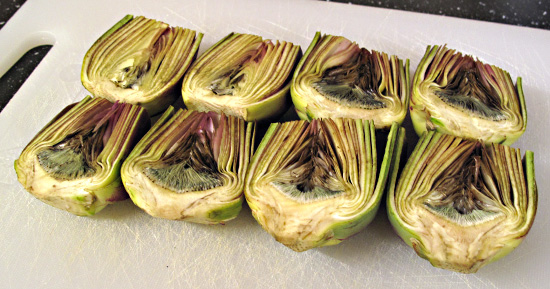
Since I don’t have a mandolin slicer here, I used my best Shun Tomato Knife, sharp and serrated, and sliced the artichokes as thinly as I could. (I left the furry inner parts, figuring they hadn’t gotten prickly.) I put it all in a bowl with the grana padano cheese (a nutty, almost sweet, hard cheese similar to parmesan), abundant lemon juice and extra virgin olive oil. Shook a little sea salt and grated some fresh pepper then gave it a gentle tossing.
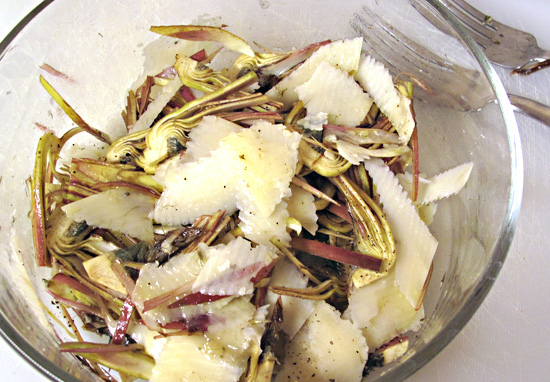
With my heaped serving of “Insalata di Carciofi Crudi”, I ate Norwegian, farm-raised salmon seasoned with Seattle’s Tom Douglas’ sweet/peppery Salmon Rub. The salad will become one of my new favorites. (If nothing else, it’s certainly good for the roughage!) But are the artichokian flowers available in the States?!
